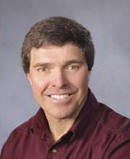 As a competitive distance runner in high school and college, I discovered cycling later in life. Too late, considering my nine foot surgeries that resulted from too much running.
As a competitive distance runner in high school and college, I discovered cycling later in life. Too late, considering my nine foot surgeries that resulted from too much running.
The bicycle is an extremely energy efficient machine, and cycling is an excellent exercise for enhancing cardiovascular endurance. Like running, power is generated by the leg muscles. Unlike running, there are no landing forces to the feet, legs, and back, which reduces the risk of impact injuries. Nonetheless, like any repetitive movement activity, cycling stresses some muscles more than other muscles, which may lead to overuse injuries.
Let's examine the major muscle involvement in cycling. The power stroke in cycling is produced primarily by contraction of the quadriceps muscles (knee extension) and the hamstrings muscles (hip extension). Although the gluteal muscles are also involved in hip extension, the biomechanics of cycling emphasizes the knee extensors (quadriceps).
Lower leg contributions to cycling include the calf muscles for ankle extension, and the anterior tibial (shin) muscles for ankle flexion. Although the calf muscles are involved in every pedal push, the anterior tibial muscles are limited to up upward pulling movements against the toe clips.
The cycle racing position places considerable stress on the upper body muscles, including the triceps, shoulders, lower back, upper back, chest, forearms, and neck extensors. Properly positioned handlebars more evenly distribute the upper body muscle involvement, but longer rides may fatigue some muscles more than others. For example, the neck extensor muscles work continuously to hold the head up, and are likely to tire before the other upper body muscles.
The triceps muscles, front shoulders and lower back are primarily responsible for maintaining the torso position. The upper back and chest provide stability for the upper arms, and the forearms maintain a firm grip on the handlebars.
Like all athletes, cyclists should strengthen all of their major muscle groups through a comprehensive program of resistance exercise. That is, they should train both the prime mover muscle groups and the antagonist muscle groups to develop balanced muscle strength and to ensure joint integrity. Training only the prime mover muscles typically leads to overuse injuries because one side of a joint becomes much stronger than the other side, and the weaker structure is eventually overpowered and damaged.
This does not imply that opposing muscle groups should be trained to equal strength. For example, the neck extensor muscles are inherently larger and stronger than the neck flexor muscles. However, both of these muscle groups should be addressed in a sensible strength training program.
Sample Strength Training Program for Cyclists
It is usually advisable to work the larger muscle groups of the legs before the smaller muscle groups of the torso, arms, and neck. However, within each muscle group it may be preferable to perform rotary exercises before linear exercises. In this manner, single joint exercises performed with less resistance precede multi-joint exercises performed with more resistance.
Selection
Table 1, presents recommended exercises for the major muscle groups in appropriate order of performance.